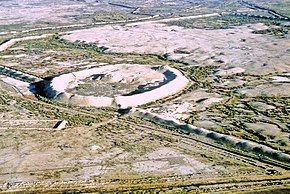Marw
| Merw (Turkmen) | |

Aerial view of Merv
|
|
| Alternate name | Alexandria Antiochia in Margiana |
|---|---|
| Location | Near Mary, Turkmenistan |
| Region | Central Asia |
| Coordinates | 37°39′46″N 62°11′33″E / 37.66278°N 62.19250°ECoordinates: 37°39′46″N 62°11′33″E / 37.66278°N 62.19250°E |
| Type | Settlement |
| History | |
| Cultures | Persian, Buddhist, Arab, Seljuk, Mongol, Turkmen |
| Site notes | |
| Condition | In ruins |
| Official name | State Historical and Cultural Park "Ancient Merv" |
| Type | Cultural |
| Criteria | ii, iii |
| Designated | 1999 (23rd session) |
| Reference no. | 886 |
| State Party | Turkmenistan |
| Region | Asia-Pacific |
Merv (Turkmen: Merw, Persian: مرو, Marv), formerly Achaemenid Satrapy of Margiana, and later Alexandria (Ἀλεξάνδρεια) and Antiochia in Margiana (Greek: Ἀντιόχεια τῆς Μαργιανῆς), was a major oasis-city in Central Asia, on the historical Silk Road, located near today's Mary in Turkmenistan.
Several cities have existed on this site, which is significant for the interchange of culture and politics at a site of major strategic value. It is claimed that Merv was briefly the largest city in the world in the 12th century. The site of ancient Merv has been listed by UNESCO as a World Heritage Site. (See List of World Heritage Sites in Turkmenistan)
Merv has prehistoric roots: archaeological surveys have revealed many traces of village life as far back as the 3rd millennium BC and have associated the area culturally with the Bactria-Margiana Archaeological Complex. The geography of the Zend-Avesta (commentaries on the Avesta) mentions Merv (under the name of Mouru) along with Balkh. In Zoroastrianism, the god Ahura Mazda created Mouru as one of sixteen perfect lands.
...
Wikipedia

